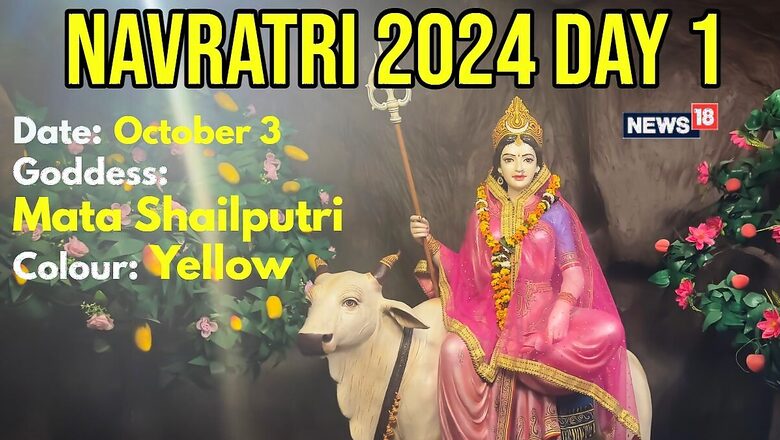
views
Shardiya Navratri, a vibrant Hindu festival dedicated to Goddess Durga, will commence on October 3 and conclude on October 12. Celebrated in the month of Ashwin according to the Hindu calendar, this nine-day festival features lively rituals, fasting and cultural performances throughout the country. The festival embodies devotion and community spirit as devotees engage in various traditions to honour the goddess. The celebration culminates on the tenth day with Dussehra (Vijayadashami), symbolising the triumph of good over evil.
Navratri 2024 Day 1: Worshiping Mata Shailputri
Shardiya Navratri Day 1 is dedicated to Mata Shailputri, which indicates the beginning of Navratri fasting and spiritual purification. Devotees are blessed with purity, strength and stability, with rituals associated with Root Chakra. It brings people together, fosters collective devotion and celebrates culture.
Navratri 2024 Day 1 Colour: What It Symbolises
Traditionally, yellow is considered a lucky colour for the first day of Shardiya Navratri. It symbolises joy, light and an abundance of energy. Additionally, yellow reflects nature and is associated with growth, fertility, peace and serenity. It is associated with the Goddess Shailputri, who symbolises strength as well as purity.
Each day of the festival is dedicated to different forms of Goddess Durga, and the colours are believed to embody the qualities of those forms.
Puja Vidhi for Mata Shailputri on Day 1
The worship of Mata Shailputri on the first day of Shardiya Navratri involves a series of rituals:
Preparation
- Wake up early and take a bath.
- Put on fresh clothes, preferably in the colour associated with the day.
- The Puja area must be then cleaned properly.
Ghatasthapana (Kalash Installation)
- Prepare a Kalash with water, coins, supari (betel nut) and doob (grass) for making the arrangements.
- Lay five mango leaves on the Kalash and put a coconut on it.
- Place a red cloth on a raised platform or an altar preferably in the eastern direction.
- Putrify an idol or image of Mata Shailputri.
Worship Steps
- To start it is preferred to initially pray to Lord Ganesha to help eliminate or avoid any disturbances.
- It’s also suggested to offer new jasmine flowers, dhoop, agarbatti and kumkum to the goddess.
- Pour ghee into a lamp or diya, light it and then place this on the side of the Kalash.
- Chant the following mantra: “Om Hreem Kleem Shailputryai Namah”.
- Perform aarti and ring the bell to invoke divine blessings.
Concluding Rituals
Bhog (food offerings) should be done soon after completing the puja.
Shubh Muhurat for Navratri Day 1 Ghatasthapana
The most auspicious moment for Ghatasthapana on Navratri Day 1 is on the Pratipada Tithi of Sharad Navratri. It is usually performed at the extremely auspicious Abhijit Muhurat.
As per Drik Panchnag, Ghatasthapana Muhurat timings are as follows:
- Start Time: 6:15 AM
- End Time: 07:22 AM
Abhijit Muhurat:
- Start Time: 11:46 AM
- End Time: 12:33 PM
Bhog to Offer Mata Shailputri on Navratri Day 1
- Pure MilkConsidered to represent purity and it is taken as the main ablations to the goddess.
- HoneySymbolises sweetness and is presented to wish a happy and prosperous life.
- GheeUsed in many preparations as it symbolises wealth.
- SugarPromised to spread sweetness and joy to the lives of devotees.
- Seasonal FruitsA combination of fresh fruits represents a healthy life.
- CoconutHas meanings related to success and prosperity; therefore, being often offered during puja.
- Sabudana KhichdiSabudana (tapioca pearls) is cooked with ghee and is opted by the fasting devotees during all festivals, as it is pure or auspicious.
- KalakandA sweet which is made from milk, and is also enjoyed during this time.
- Kheer (Rice Pudding)Another preparation that is given to the goddess representing blessings of abundance is kheer which is prepared with milk and sugar.


















Comments
0 comment